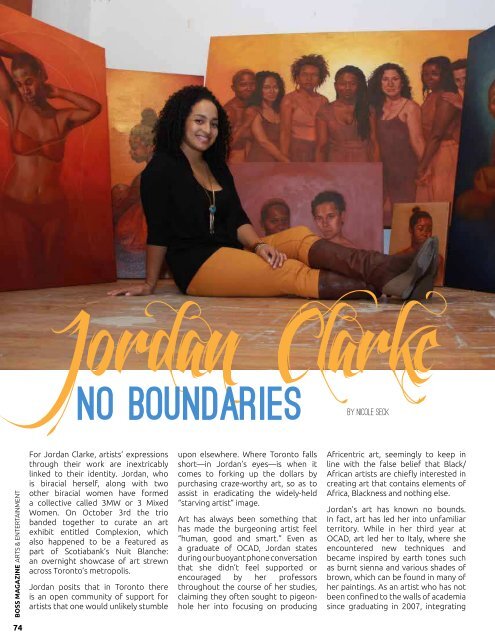You also want an ePaper? Increase the reach of your titles
YUMPU automatically turns print PDFs into web optimized ePapers that Google loves.
adoring fans. “Validation shouldn’t<br />
be important but it helps to keep one<br />
on track.” Of course, validation often<br />
leads people to belief that they are<br />
doing something right.<br />
After witnessing Jordan’s art, it is quite<br />
difficult to imagine that its creator is<br />
extremely shy and uses painting as<br />
a conduit through which she is able<br />
to communicate her thoughts and<br />
feelings. Although Jordan is fearful and<br />
at times doubtful, she remains diligent<br />
and refuses to allow fear to take over<br />
the process.<br />
And it shows in her beautiful artwork.<br />
I rounded off our phone conversation<br />
with the following Q & A with the very<br />
insightful Jordan:<br />
Does art allow you to creatively<br />
express the tensions you face as a<br />
biracial woman? If yes, how?<br />
about being biracial/mixed-race. In<br />
2012, I co-founded 3MW Collective<br />
along with Rema Tavares and Ilene<br />
Sova. Our mission is using visual art to<br />
deconstruct mixed-race identity. My art<br />
has provided me with the opportunity<br />
to connect with others and to explore<br />
relevant issues.<br />
Which of the two do you weigh more<br />
heavily: your desire to use art as a<br />
form of creative expression or the<br />
effect that your art may have upon<br />
others?<br />
I think both are important; however,<br />
if I had to choose one then creative<br />
expression would weigh more for me.<br />
I use art to express myself because<br />
it’s what feels right. I think naturally<br />
if I’m honest with myself the work<br />
will always affect somebody. Art is a<br />
universal language, and it has a way of<br />
connecting with others.<br />
Jordan Clarke<br />
No Boundaries<br />
By Nicole Seck<br />
femininity in art has been Jordan’s<br />
main focus. She has a vested interest<br />
in empowering women of the Black/<br />
African diaspora and racialized women<br />
alike.<br />
Yes, art most definitely allows me<br />
to creatively express myself and<br />
my biracial identity. It was actually<br />
through painting that I initially began<br />
looking into my identity. It all started<br />
with a painting from 2008 titled<br />
Nothing is just black or white. This<br />
painting lead to my “mask” series of<br />
self-portraits exploring mixed race.<br />
This work has acted as a stepping stone<br />
for where I am now as an artist. Before<br />
this work, I wasn’t thinking critically<br />
What do you believe to be missing<br />
from Toronto’s art landscape (if<br />
anything)?<br />
Fearless art buyers.<br />
Why art?<br />
I choose art because it makes me feel<br />
connected and complete. It allows me<br />
to see the beauty in everything.<br />
BOSS MAGAZINE ARTS & ENTERTAINMENT<br />
For Jordan Clarke, artists’ expressions<br />
through their work are inextricably<br />
linked to their identity. Jordan, who<br />
is biracial herself, along with two<br />
other biracial women have formed<br />
a collective called 3MW or 3 Mixed<br />
Women. On October 3rd the trio<br />
banded together to curate an art<br />
exhibit entitled Complexion, which<br />
also happened to be a featured as<br />
part of Scotiabank’s Nuit Blanche:<br />
an overnight showcase of art strewn<br />
across Toronto’s metropolis.<br />
Jordan posits that in Toronto there<br />
is an open community of support for<br />
artists that one would unlikely stumble<br />
upon elsewhere. Where Toronto falls<br />
short—in Jordan’s eyes—is when it<br />
comes to forking up the dollars by<br />
purchasing craze-worthy art, so as to<br />
assist in eradicating the widely-held<br />
“starving artist” image.<br />
Art has always been something that<br />
has made the burgeoning artist feel<br />
“human, good and smart.” Even as<br />
a graduate of OCAD, Jordan states<br />
during our buoyant phone conversation<br />
that she didn’t feel supported or<br />
encouraged by her professors<br />
throughout the course of her studies,<br />
claiming they often sought to pigeonhole<br />
her into focusing on producing<br />
Africentric art, seemingly to keep in<br />
line with the false belief that Black/<br />
African artists are chiefly interested in<br />
creating art that contains elements of<br />
Africa, Blackness and nothing else.<br />
Jordan’s art has known no bounds.<br />
In fact, art has led her into unfamiliar<br />
territory. While in her third year at<br />
OCAD, art led her to Italy, where she<br />
encountered new techniques and<br />
became inspired by earth tones such<br />
as burnt sienna and various shades of<br />
brown, which can be found in many of<br />
her paintings. As an artist who has not<br />
been confined to the walls of academia<br />
since graduating in 2007, integrating<br />
Jordan finds it important to place<br />
some amount of thought into<br />
everything that she creates, claiming<br />
that there must be a vision as to why<br />
it is we do the things we do. “When<br />
you inspire others they give back to<br />
you,” says the self-proclaimed ubershy<br />
artist. As life for most is a process<br />
of learning and development, it is not<br />
surprising that Jordan’s objective is<br />
to continue along her journey toward<br />
artistic development for the purpose<br />
of creating inspirational pieces for<br />
others. But behind her desire to<br />
create inspirational works that others<br />
can feast their eyes on, lies Jordan’s<br />
admission of feeding off of aweinspired<br />
and positive sentiments of<br />
WINTER 2013 BOSS MAGAZINE<br />
74<br />
75


